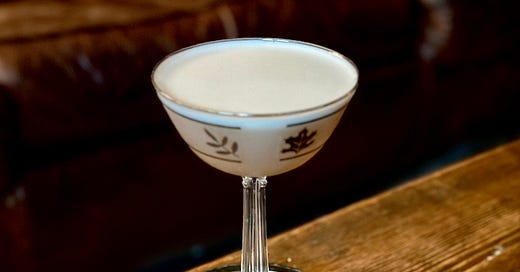It’s Whiskey Sour Season
A pair of easy, eggy whiskey sour riffs from Harry Craddock and The Savoy Cocktail Book.
I understand that many of you are ready to start drinking Old Fashioneds and Manhattans. Be my guest, of course. I promise we’ll get there soon.
But when October rolls around, and the crickets and the rust-beetles scuttle among the nettles of the sage thicket, and the friscalating dusklight still lingers for an hour or two after work, well, what I really want is a whiskey sour.
That’s especially true at the start of the month, when it’s still warm enough that the dogs come in panting after their evening stroll. The tinted warmth of fall is different in kind than the muggy heat of summer, but even still: Heat is heat. And heat means drinks that are juicy and tangy and bright.
There will be plenty of time for Old Fashioneds later. This is Whiskey Sour Season. Enjoy it.
Of course, when I say it’s Whiskey Sour Season, I don’t only mean that I want a Plain Old Whiskey Sour.
Often, I mean I want something that’s a lot like a Whiskey Sour, but not precisely a Whiskey Sour. Something in the Whiskey Sour family. A Whiskey Sour — but with a little twist.
Fortunately, there are many such drinks in the cocktail canon. Today, I want to spotlight two, both from Harry Craddock’s incredibly influential, perpetually valuable 1930 Savoy Cocktail Book.
Both of these drinks take the basic whiskey sour template — a frothy mix of whiskey, lemon juice, sugar, and (often but not always) egg white — and add a single ingredient, giving these cocktails just enough distinctive character to set them apart from their progenitor.
Not only are these easy to make, relying on just a handful of relatively common ingredients, they are both useful demonstrations of the way that the addition of a single ingredient can alter a drink’s character.
Also, rather conveniently, they are delicious.
The Whiskey Sour and Its Offspring
The core Whiskey Sour template has remained roughly the same for a century and a half.
As a reference point, the 1887 edition of Jerry Thomas Bartender’s Guide renders the recipe like so:
Take 1 large tea-spoonful of powdered white sugar, dissolved in a little Seltzer or Apollinaris water.
The juice of half a small lemon.
1 wine-glass of Bourbon or rye whiskey.
Fill the glass full of shakeved ice, shake up and strain into a claret glass. Ornament with berries.
Today, we would typically use pre-batched syrup rather than sugar dissolved in water (although the idea is more or less the same. We now have standard measurements that would produce something on the order of a 2:1:1 or 8:3:3 ratio of whiskey:lemon:sugar syrup. An egg white — which some early recipes called for — may or may not be part of the drink. Few contemporary whiskey sours are ornamented with berries.
But the underlying idea has stayed remarkably stable. It’s a basic sour — something like a Daiquiri but with whiskey instead of rum.
Invariably, however, any long-running idea in the cocktail universe invites twists. It’s true now, and it was true a century ago: Where there is one good drink, there are always more good drinks.
So it’s no surprise that by 1930, when Harry Craddock publishes The Savoy Cocktail Book, there are multiple twists on this idea.



